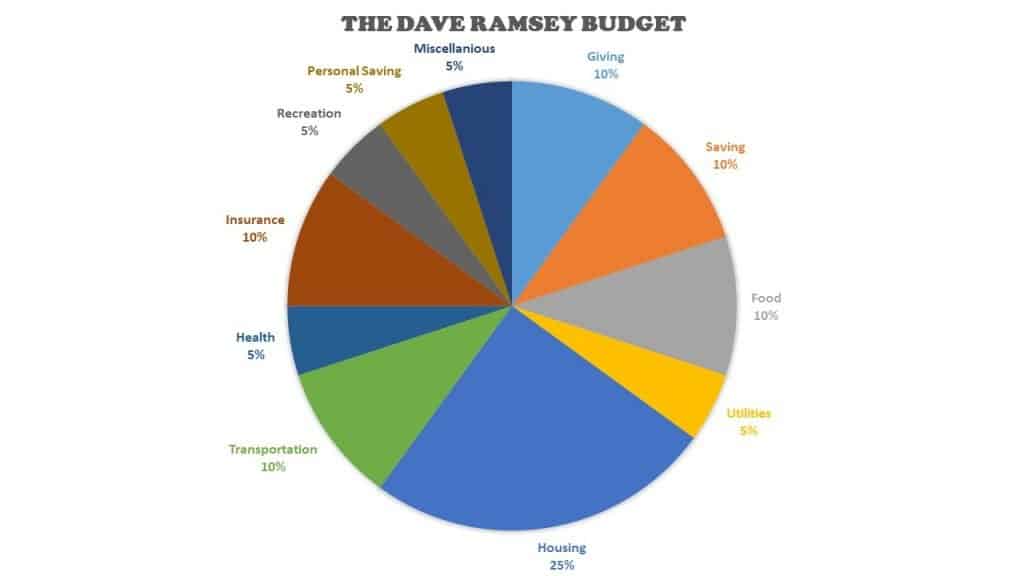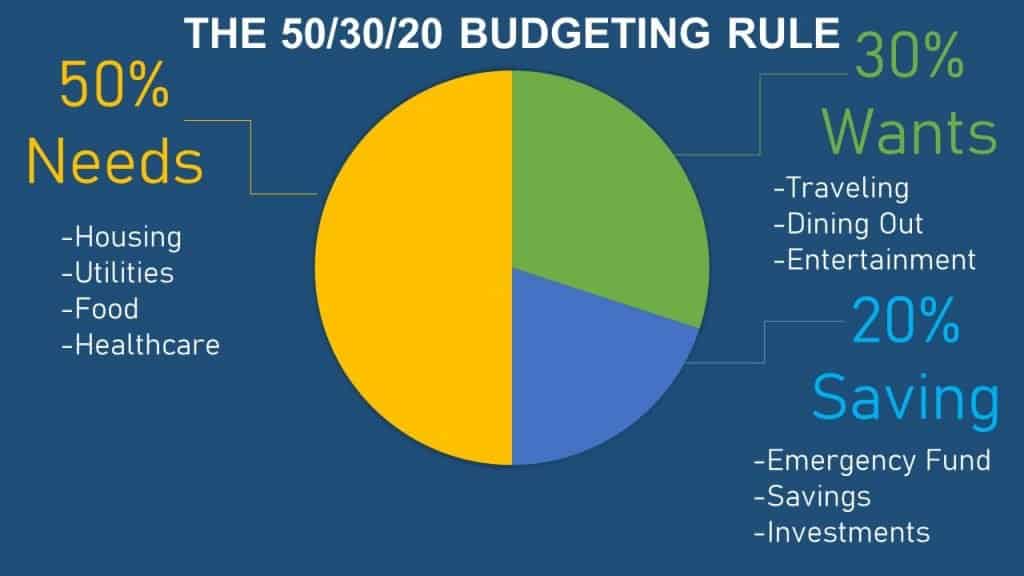Creating a budget can be a hard thing to do. We have to break it down into categories. Allocate different types of money for certain expenses, and quite honestly, it can be challenging. Who wants to budget in the first place? It would be easier to just not knowing, am I right? Wrong! Having a budget is a great place to start to figure out where your money is going. The self-proclaimed guru, Dave Ramsey, has once again worked on making budgeting easy with his budget. He came up with his version of budgeting called The Dave Ramsey Budget Percentages.
There are many types of budgets out there. The good thing about Dave Ramsey is that he actually gets people to start a budget. I know what it is like living without a budget. You are not aware of how much money you spend on food, housing, and transportation.
At the end of the month, there is no more money in your bank account. Every month is the same. You are on a journey through life, and you have no plans for your money except for spending. That is how Dave Ramsey got people to start budgeting. People listen to him, and he makes things either black or white.
Let’s learn about his budget and see if it applies to us. I figure it is good to learn about because, who knows, this can start people on the right track to budgeting and making a financial difference in their life.
The Dave Ramsey Budgeting Percentages.
- Giving- 10%
- Saving- 10%
- Food- 10-15%
- Utilities- 5-10%
- Housing- 25%
- Transportation- 10%
- Health 5-10%
- Insurance 10-25%
- Recreation 5-10%
- Personal Spending 5-10%
- Miscellaneous 5-10%

Household Budget Categories Descriptions:
Giving (10%)
Dave is all about giving and particular giving to the church and other charities. I believe in the same thing. A couple at my church once said to my wife and me, “It is blessed to be a blessing.” From that saying, we often realize that we have been blessed with so much, and therefore we want to go out and bless other people.
This may be giving money to our church, buying lunch for our staff at work, or even funding charitable organizations. Giving is a part of Dave’s budget because he believes that our focus should not be on money but on what we have so we give to others.
Saving (10%)
Dave Ramsey is all about saving for that emergency fund. In the Dave Ramsey Baby Steps, he makes sure to have everyone in Baby Step #1: Save $1000, Emergency Fund. That is great. Being able to save is something you should put in your budget. After you have your emergency fund, Dave recommends starting investing and saving for retirement.
People should have saving goals that are a part of their budget. Maybe it is to help with debt payoff or to have some fun money for a trip. When you save money you set aside extra money for goals and emergencies.
Food (10-15%)
Food is the part of the budget that is for eating out or eating in. We need to budget a certain amount of food for each month. My wife thinks about a certain amount of money that costs per person per meal and keeps our budget in that range. You can do this however you like, but be mindful of the amount of money you are spending. This can be helped by making a list when you go grocery shopping or to cut down on the meals you eat out
Utilities (5-10%)
Utilities are straightforward. It is the amount of money you spend on electricity, water, internet, and even trash take out. Please take a look at these costs and factor them into your budget.
Housing (25%)
Housing is probably the most significant expense for most people. This is also the one expense that can throw your budget out of whack. So it is helpful to know how much income you have coming in and try to keep housing lower.
Dave Ramsey recommends making sure to calculate everything. That is a mortgage, rent, HOA fees, insurance, and even maintenance on the housing. All of these costs can add up. So it is best to be able to budget for them.
Transportation (10%)
Being able to get from point A to point B is necessary. Transportation is a cost that you must account for in your budget. This can be the amount of gas you put into your vehicle, public transportation, repairs, taxes, and anything else
Health (5-10%)
Getting sick will happen to people. You need to be able to have budgeted money in case you need to go to the doctor. It is better to have that money there just in case you get sick.
Insurance (10-25%)
Insurance is something we all need. Health Insurance can be costly, but not having it could be even worse. You will also need insurance on your vehicle, housing, and even some good life insurance if something tragic happens. It is better to be insured than to not have anything at all.
Recreation (5-10%)
This is for your lifestyle and hobbies. We need to enjoy some life going to movies, concerts, and enjoying things. So make sure you have some money under the recreation part of your budget. You can also put this under other hobbies like camping and hiking.
Personal Spending (5-10%)
These are the things in your budget that you allocate to personal spending. Sometimes we want to have exceptional food that we usually don’t have. This can be getting a haircut or buying alcohol. Personal spending can be individual that you have put in your budget.
Miscellaneous ( 5-10%)
Miscellaneous is for the things that are not apparent at the beginning of the month. Maybe you need to purchase some batteries. There could be a reason for making a purchase that does not fit in any categories like gifts or even going to a wedding. This can be put in the miscellaneous category.
Are These Categories Realistic?
That is the big question. As I have written before on The Dave Ramsey Baby Steps, some of his stuff is outdated and a little not realistic. Many things may need to change. For instance, saving just 10% is not realistic. Having 25% for housing may not be practical to some people.
Dave Ramsey tried to make a budget simple for people. It works. Each person is different, and it fails to cover things we need in a budget like debt payments and retirement savings. I use these same categories, but they are not the same percentage as Dave recommends.
What about Debt Payments?
With all these categories and the baby steps recommending debt repayments, how do you fit these all in together? It is a hard thing to think about. Debt repayments should come before some things. An easy way to get out of debt is to stop spending money. This sounds easy, but if you can cut down on spending, you can eliminate debt easier.
It will become a habit of cutting some spending amounts by having a better budget or budgeting method. So start with something that you do not need. See if you can cut down on housing costs or even food costs. These can be ways to stop spending as much money and putting that money towards your debt.
How Much Should You Save?
In the Dave Ramsey Budget Percentages, he says to save 10%. Well, I hate to be the bearer of bad news, but 10% is not enough to save for retirement. Dave Ramsey advocates to save 15% for retirement., but the Dave Ramsey Budget doesn’t account for this.
When you are saving, most people have different amounts. I would suggest saving and investing over 20% of your money. Having a 15% savings rate is very low indeed and at 10% is even lower. As we get closer to retirement, we want to ensure that our money and investments can cover the amount we need to retire.
I do my net worth calculations every month. If you want to see how much you need that includes your house, you can calculate your liquid net worth. You can use a spreadsheet or an app that way you see your net worth increase. Your savings rate is a massive part of being able to retire financially well. The more you save and invest early on, the better it will be when you stop working.
My wife and I aim for 50% savings every month. Most months, we are saving close to 60%, but we have a goal to stop working early on in our life, so we strive to have a high savings rate.
Make Saving fun with Yotta Savings. It is like the lottery where you can win money at the end of the week.
A Look Into My Budget:
My monthly budget percentages are pretty simple and very low percentage-wise compared to Dave Ramsey Budget percentages.
Here they are:
- Save/Invest (64%)
- Tithe (10%)
- Housing (14%)
- Food (5%)
- Utilities (1%)
- Miscellaneous (1%)
- Transportation (1%)
- Health (3%)
- Personal Spending (1%)
My wife and I live in a low cost of living area, and we strive to live below our means every month. We also have a considerable focus on saving and investing for our future. The more we can invest and save now, the earlier we can stop working and focus on our projects.
We do believe in giving, so we give every month. This can be to our church, friends, or even to some charitable organization.
What About Other Budget Systems?
Most of this post has been about the Dave Ramsey Budget percentages. There are other budgets out there that people can take a look at. Each system is different and provides opportunities for others to create a budget that works for them.
- 50/30/20
- 70/20/10
- Envelope System
- Reverse Budgeting.
The 50/30/20 Budget

Senator Elizabeth Warren popularized the 50/30/20 budget. She came up with this idea. It breaks down your budget into basic three categories to help you budget better:
- 50% Needs
- 30% Wants
- 20% Saving
50% is for Needs:
Half of your budget should go to things you need. This can be housing, food, transportation, and utilities. So you can budget half your money for these things.
30% will go towards Wants:
These will be the things you want. It can be personal spending, entertainment, and other things you may not need but would like to have.
20% For Saving:
The good part of this is that it emphasizes saving. The more you save, the better your financial situation will be in the future. By saving 20%, you could retire a good ten years earlier than saving just 10% of your income, as the Dave Ramsey Budget suggests.
This budget is straightforward to follow. Break everything down into three different categories and make it work. It will not work for everyone, so adjust and make it work for you.
The 70/20/10 Budget:
This is very similar to the past budgets as well. Let’s break this down.
70% Monthly Expenses:
That is everything you spend. 70% of your budget goes to monthly expenses. This can be anything from housing to personal spending. It will be all calculated in the monthly costs.
20% Savings
Remember to continue to save your money. 20% of your money goes to savings. That is very important. I think I have mentioned this a couple of times already.
10% Tithe:
People do believe in being generous and donating money. Money isn’t everything. There is more to life than money, so we should be generous with it.
The Envelope Budget System
The envelop system is a simple way to budget by separating your money into different envelopes. It can also be called Zero-Based budgeting. You put the money in each envelope and then you spend that amount of money. If it is all gone, you cannot spend more money. This helps in making you more disciplined.
The envelope budget system allows you to take the monthly income and equal zero at the end of the month. So each dollar has its own place. Once it is spent, you cannot spend until the next month.
Some people will spend until there is no more money. It also allows you to budget your money across different systems.
Reverse Budgeting.
Reverse Budgeting takes concepts from Warren Buffett’s quote “Pay Yourself First.” At this point, you will pay yourself first. Money going towards savings will be paid first. Then you will not have to worry about spending it. All the money leftover is for your other bills.
This method helps you put saving as a priority first. You will then have to adjust to your new budget and cut spendings where needed to continue paying yourself first.
Time To Make A Budget
The time is now to start. You have the tools to make your budget. There are many categories that Dave Ramsey Budget Percentages has provided you. We have to start budgeting our money.
To plan for future financial goals, you need to know where you are. The first place you can start is tracking your spending. To see where you want to go, you need to follow to see where your money is going. At that point, you can then budget and cut unnecessary expenses.
These tools will be practical to change your life.
Final Thoughts:
I know learning about budgeting is not the most fun thing. It is a part of personal finance. Budgeting started to help me create more wealth, and I wanted to show you how it is done. The Dave Ramsey Budget Percentages are simple and effective. They have some issues, but not every plan will fit every person. You need to modify, adjust, and make things work for your situation.
My budget will not work for people as well. It is because I live on less. Being frugal is something I know will help create wealth for me in the future. It is time to start to make a plan. The time is now to start tracking your spending and making a budget. You can use The Dave Ramsey Budget, 50/30/20, the 70/20/10, or the reverse budget. Do something that works for you.
How do you budget?

I’m Steve. I’m an English Teacher, traveler, and an avid outdoorsman. If you’d like to comment, ask a question, or simply say hi, leave me a message here, on Twitter (@thefrugalexpat1). Many of my posts have been written to help those in their journey to financial independence. I am on my journey, and as I learn more I hope to share more. And as always, thanks for reading The Frugal Expat.







